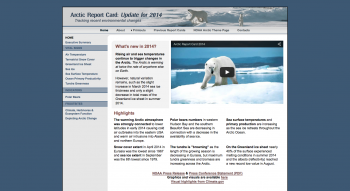
The 2014 Arctic Report Card was released on 17 December 2014 during a press conference led by Martin Jeffries, Principal Editor of the Arctic Report Card and Program Officer for Arctic and Global Prediction at the Office of Naval Research. Other speakers at the press conference were co-editor Jackie Richter-Menge of the U.S. Army Corps of Engineers, Cold Regions Research and Engineering Laboratory (CRREL), Geoff York of Polar Bears International, and Craig McLean of NOAA's Office of Oceanic and Atmospheric Research (OAR).
This is the eighth annual update to the Report Card, which provides reports on key indicators and components being tracked in the Arctic. The 2014 update contains 10 essays by 63 scientists from 13 different countries. Each essay was subject to an independent peer-review organized by the Arctic Monitoring and Assessment Programme (AMAP) of the Arctic Council.
The 2014 Report Card is structured differently than those published previously. This year there are three sections entitled "Vital Signs," "Indicators," and "Frostbites." The "Vital Signs" section includes seven topics that have appeared in previous Report Cards and will be updated annually in the future: air temperature, terrestrial snow cover, the Greenland Ice Sheet, sea ice, sea surface temperature, ocean primary productivity, and tundra greenness. The "Indicators" section also includes topics that have appeared in previous Report Cards, but will now be updated every 2-4 years. Examples of these topics include ozone, UV radiation, permafrost, and glaciers and ice caps. The "Frostbites" section is entirely new and will feature reports on new and newsworthy items, describe emerging issues, and address topics that relate to long-term scientific observations in the Arctic. Two articles are featured in the 2014 "Frostbites" section. One focuses on how climate and herbivore size affect the workings of the Arctic terrestrial ecosystems. The second article focuses on the importance of choosing a reference period of study since it can affect how the magnitude of climate change is depicted.
Another addition is the Editorial Advisory Board, formed for the 2014 Report Card and subsequent issues, which advises the editors on the choice of topics for the "Indicators" and "Frostbites" sections, and participates in the internal review of the Report Card prior to the independent peer review.
Highlights from the 2014 Report Card include:
Rising air and sea temperatures continue to trigger changes in the Arctic. However, natural variation remains, such as the slight increase in March 2014 sea ice thickness and only a slight decrease in total mass of the Greenland Ice Sheet between June 2013 and June 2014.
The warming Arctic atmosphere was strongly connected to lower latitudes in early 2014, causing cold air outbreaks into the eastern U.S. and warm air intrusions into Alaska and northern Europe.
Snow cover extent in April 2014 in Eurasia was the lowest since 1967, and sea ice extent in September was the 6th lowest since 1979.
Polar bear numbers in western Hudson Bay and the southern Beaufort Sea are decreasing in connection with a decrease in the availability of sea ice.
The tundra is "browning" as the length of the growing season is decreasing in Eurasia, but maximum tundra greenness and biomass are increasing across the Arctic.
Sea surface temperatures and marine primary production are increasing as the sea ice retreats throughout the Arctic Ocean.
On the Greenland Ice Sheet nearly 40% of the surface experienced melting conditions in summer 2014 and the albedo (reflectivity) reached a new record low value in August.
The Report Card editorial team is:
Martin Jeffries, Office of Naval Research, Arlington, Virginia;
James Overland, NOAA Pacific Marine Environmental Laboratory, Seattle, Washington; and
Jackie Richter-Menge, U.S. Army Corps of Engineers, Cold Regions Research and Engineering Laboratory, Hanover, New Hampshire.
Financial support for the Arctic Report Card is provided by the Arctic Research Program in the NOAA Climate Program Office, and in-kind support is provided by the Office of Naval Research.
The 2014 Arctic Report Card, a link to a YouTube video, and previous report cards are available on the Report Card website. Visual highlights from the Report Card are available on NOAA's Climate.gov website.
More information about the 2014 Arctic Report Card is available here. For questions contact Martin Jeffries (martin.jeffries [at] navy.mil) or Jackie Richter-Menge (Jacqueline.A.Richter-Menge [at] usace.army.mil).
Many thanks to Martin Jeffries and Jackie Richter-Menge for their review and contributions to this article.
